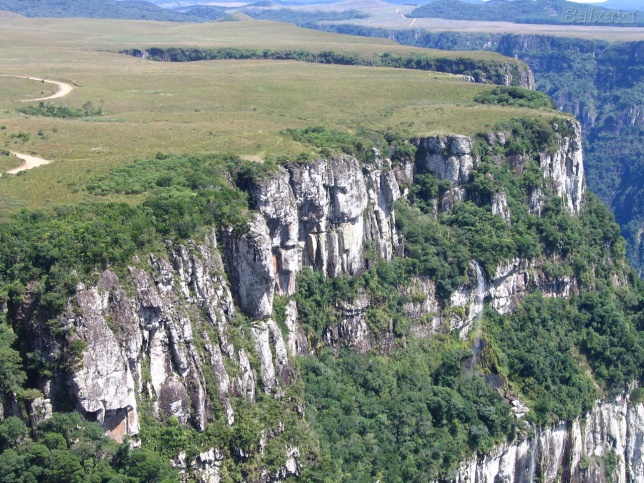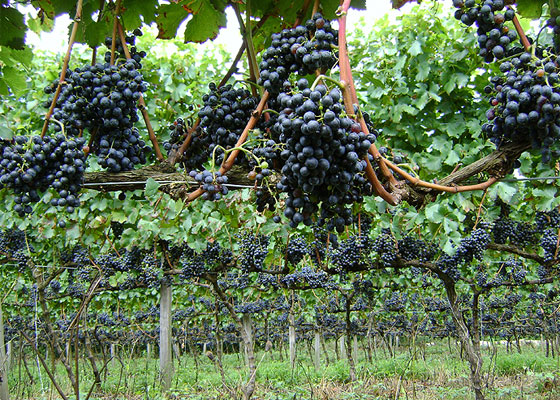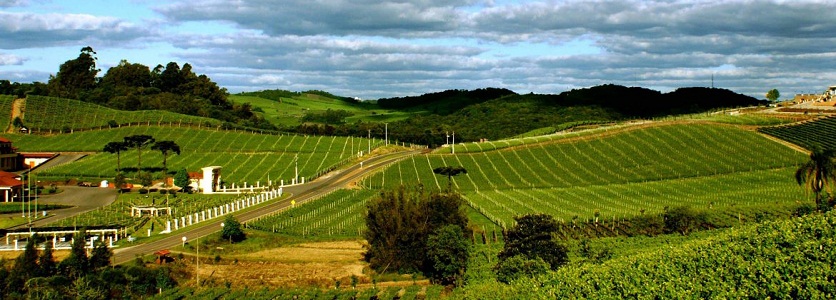Chapter 1 – What’s Serra Gaúcha?
Located in southern Brazil, more precisely in the state of Rio Grande do Sul and with a climate similar to the larger winemakers European countries, Serra Gaúcha offers endless options for tourism and wine tourism, it brings together the beauty of Brazilian landscapes to European lifestyle brought by Italian and German immigrants who knew how perpetuate their customs and traditions in Brazilian territory as well as the wine industry.

Rio Grande do Sul State

Rio Grande do Sul State Regions

Rio Grande do Sul Coat of Arms

Serra Gaúcha Wine Regions
The state of Rio Grande do Sul borders with Uruguay to the south, to the west with Argentina – another great producer country of quality wines with worldwide recognition – to the North with the State of Santa Catarina, which promises to be a major producer of wines in the future, and to the east the state is bordered by the Atlantic Ocean.
Its privileged position, below the Tropic of Capricorn, allows the climate is of two types: the subtropical and the oceanic climate.
What is Serra Gaúcha?
The state of Rio Grande do Sul is covered mainly by plains that cover 70.4% of its territory with altitude below 300m. Only a small portion known as Serra Gaúcha rises above 900 meters in altitude. The Serra Geral, conglomerates mountains which Serra Gaúcha is a part and begins in São Leopoldo with an average altitude of between 1,100 and 1,200 meters.
Serra Gaúcha region was settled primarily by German and Italian immigrants, hence their culture connected to the world of wines. Being a very cold region in winter, suitable for the production of quality wine, the vine has adapted well to the climate of the region. Moreover, thanks to the savoir-faire of Italian and German immigrants in the manufacture of this precious drink, the wine industry has been improving and perfecting their wines as ever. Serra Gaúcha is still considered one of the coldest regions of the country.

Panoramic sight of Serra Gaúcha

Roads ornated by hortências

Panoramic sight of Serra Gaúcha

Panoramic sight of Serra Gaúcha
The fact of being located in the temperate zone, the seasons in Serra Gaúcha are well defined, with a hot summer, although the mountain climate ensures a certain freshness. Winter is quite cold, with the possibility of snow in the region, although it is still a rare phenomenon in Brazil. Nonetheless, winter days are sunny and great for walks. Winter is the most advisable time for wine tourism and to visit the region. The few but welcome snowfalls are a joy for mostly Brazilian tourists who dream about the phenomenon.
Serra Gaúcha and the culture of wine
The Grape and Wine Region, in Serra Gaúcha today comprises 47 municipalities: Antônio Prado, Barão, Bento Gonçalves, Boa Vista do Sul, Camargo, Carlos Barbosa, Casca, Caxias do Sul, Ciríaco, Cotiporã, David Canabarro, Flores da Cunha, Fagundes Varela, Farroupilha, Garibaldi, Guaporé, Ipê, Monte Belo do Sul, Muliterno, Nova Alvorada, Nova Araçá, Nova Bassano, Nova Pádua, Nova Prata, Nova Roma do Sul, Pinto Bandeira, Protásio Alves, Santa Tereza, Santo Antônio do Palma, São Domingos do Sul, São Marcos, Serafina Correa, Vanini, Veranópolis, Vila Flores, Vila Maria and Vista Alegre do Prata.
The region features in the landscape one of its most beautiful assets. They are mounds, hills, valleys and rivers that are inside an environment with numerous options, activities and opportunities for visitation.



The cultivation of the vine is present in 16 of its 24 counties: Antônio Prado, Barão, Bento Gonçalves, Carlos Barbosa, Casca, Cotiporã, Flores da Cunha, Farroupilha, Garibaldi, Guaporé, Monte Belo do Sul, Nova Araçá, Nova Bassano, Nova Pádua, Nova Prata, Nova Roma do Sul, Protásio Alves, Santa Tereza, Santo Antônio do Palma, São Marcos, Serafina Correa, Veranópolis and Vila Flores.
One of the experiences offered is to monitor the winemaking and tasting the results of these operations in the canteens. There are 83 options, from small family businesses to traditional wineries in the region.
You cannot miss the opportunity of visiting the attractions tours that delight tourists from all parts of Brazil and the world, here are some of them:
Our Culture in the Rural Middle — that presents the Roteiros Caminhos da Imigração, Caminhos de Pedra, Caminhos de Faria Lima, Caminhos do Salto Ventoso, Vale do Rio das Antas, from the past to the future [new Roteiro de Carlos Barbosa], Caminhos da Colônia, Estrada do Imigrante and Estrada do Sabor and the most recent Desvio Blauth, between Farroupilhas and Garibaldi.


The Caminho das Pedras is part of the cultural heritage of Rio Grande do Sul and it is located in the rural area of the municipality of Bento Gonçalves in Serra Gaúcha. With 12 km long, along the way we found numerous stone houses, small wineries and colonial houses turned into dining spaces – hence the name “Path stones”. It’s a real diving in Italian culture with the right wine tasting, music, and enjoying wonderful hospitality and scenery.
WINES — The Soul of the Region, Vale dos Vinhedos, Rota das Cantinas, Rota dos Espumantes, Vinhos de Pinto Bandeira, Vale Trentino, Vinhos e Longevidade, Vinhos dos Altos Montes and Vinhos e Espumantes de Monte Belo do Sul. The Casca wines, represented by Don Abel winery, Wines and Sparkling of Guaporé, in the Ghellen and Giaretta winery, among other new spaces to wine tourism in other cities.




All this must have given you a strong desire to know the region, mustn’t it? But the Serra Gaúcha is not only known for its fantastic wines. It also offers many opportunities for recreation, sports, relax for those who need plenty of rest and vacation. You can practice from extreme sports for thrill seekers, or milder sports like hiking. Here are some options you can choose when you’re there:




Canoeing, visits to waterfalls, climbing hills, jumps in Tyrolean or “bungee jumping”, by hiking trails that lead us to the history of colonization and wine culture in the region. These are some of the multiple choices of entertainment and fun for those who want to not only enjoy wine, but enjoy wonderful holiday moments or prolonged contact with nature.
In our first edition of this SPECIAL ENOVÍRTUA, we learnt what Serra Gaúcha is, some of their wines, tour itineraries and sports and leisure options. In the next issue, we are going to know a little of its history, climate and organizations that made possible the Brazilian wine entering the competitiveness of the national and international market.
See you there!!





